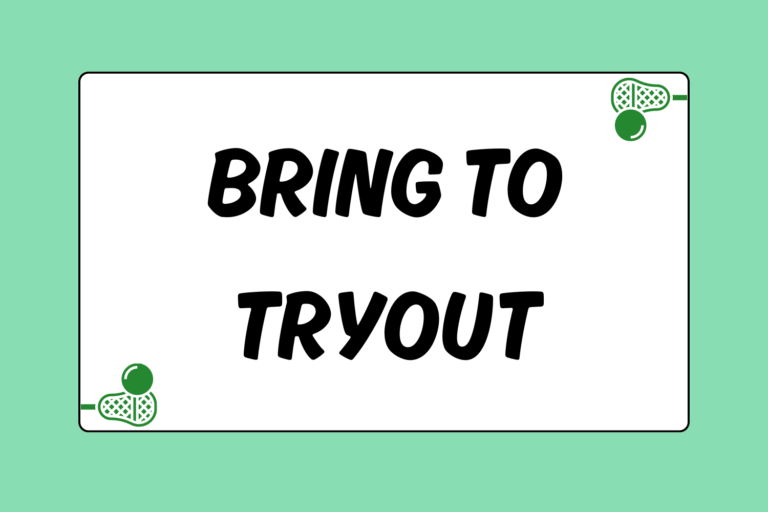Even though they may seem like just a small part of the game, ground balls are crucial to both team and individual success in lacrosse. The ability to pick up a ground ball quickly and fluidly is right up there in importance with throwing, catching, and cradling. From the team standpoint, control of ground balls means more possession time and more scoring chances, as well as keeping the ball away from the opponent’s offense.
From a personal standpoint, your effort on ground balls will show your coach and teammates that you’re committed to doing the little stuff to help your team win games. This guide will examine the technique and hustle needed to be a vacuum cleaner on ground balls and bring a valuable and underrated asset to your team.
Form & Fundamentals
Paying attention to your fundamentals is the best way to ensure that you scoop up all the loose balls and give your team valuable possession opportunities. Form is very important when the ball hits the ground, as a few simple things can allow you to snatch up GBs that lazier players will not get to.
Your hands should be as spread out on the stick as possible. With your dominant hand at the top of the shaft, and your off-hand at the bottom, grip the stick tightly when readying to pick up the ball. It won’t always be practical to have your hands spread all the way apart on the stick, but if you can help it, try to maintain that spacing.
As for the feet, try to keep them moving, and plant your front foot next to the ball when starting your scooping motion. This will provide you with something of a guide for your stick to go directly to the ball, and can also shield the ball from being scooped from the side by an opponent.
With your upper body, the first rule of thumb on GBs is that the lowest man usually wins the battle for the ball. It’s okay to take your time and worry about getting lower than someone else fighting you for the ball. Bend at the knees and waist, and get your torso over the ball, trying to be as low as possible.
Next, you’ll want to focus on the angle of your stick as you approach the ball. Do your best to get your stick as low and as close to parallel to the ground as possible when scooping the ball. If you approach the ball with your stick head pointing more towards the ground (closer to perpendicular), the odds are good that the head of the stick will catch on the ground and you will miss the ball entirely. Getting underneath the ball is the most important aspect of your stick positioning on the approach.
Scoop all the way through the ball, and bring the stick up towards your chest without trapping the ball. All the while, you should be moving your feet and getting away from defenders who will be looking to throw hard checks immediately after you pick the ball up.
Tips and Tricks
While the fundamentals always come first, there are a few tricks that every laxer should know when picking up GBs.
Although your coach may typically yell at you for raking the ball, sometimes a rake is the best way to secure the ball in the midst of a crowd. If you can get down low enough, and get the head of the stick over the ball, you can trap it for a few seconds until an opportunity to rake it into your pocket presents itself. Just be sure to stay low to avoid body checks and keep your body over the ball while you wait for your opportunity to get it into the stick.
Another sneaky trick you can do is to box out an opponent going for a one-on-one ground ball against you. Get low and literally stick your rear end out into the other guy going for the ball. You can pivot around on one foot using your butt to keep the opponent a healthy distance away from the ball as you allow yourself space and time to scoop up the ball.
If you find yourself closely trailing behind an opponent who is ready to scoop up a ball, focus on his back hand. As he gets ready to scoop the ball, apply a hard poke or slap check to his back hand. This should knock his stick off course and make him overrun the ball. You should immediately look to get low and scoop the ball, and protect your stick from the nearby opponent.
Situations and Scenarios
Ideally, every ground ball situation would just be you against the ball. Unfortunately, there are many more instances when you’ll have to fend off opponents and navigate through fast moving teammates to get to the ball. In this section, we will look at the different scenarios that players most often find themselves in with the ball on the ground, and how to be the guy that snatches up that loose ball.
One on one
In a one-on-one battle for a GB, the most important thing to focus on is your body positioning. Don’t be afraid to be physical and look to knock the opponent off the ball with your hips or rear end. If the other guy has an edge on picking it up, do your best to let him get low and think he’s going to snatch it up, and then hit his stick and hands with hard checks as he scoops the ball. Sometimes it can be a good idea to bait the opponent into thinking he’s got a clean shot at the ball, and then lay some wood and wear him down a little bit.
One on two
When trying to fend off two opponents by yourself, sometimes your best bet is not to actually pick the ball up, but rather to goose or kick the ball to a teammate or open area of the field. It can be very hard to secure a ground ball while one guy is beating on you and the other one is free to scoop it up, so simpler can be better in these situations.
If you know that a teammate is approaching the scrum, try to get the head of your stick down to the ball and flick it out towards the approaching teammate. This action requires significantly less effort than getting in there and fighting for it, and also can be performed more easily than a traditional scoop. A successful goose or kick to a teammate in the offensive end of the field can result in an unsettled advantage for your team’s offense, as two of the other team’s defenders will be out of the play and scrambling to recover. Moving the ball quickly can result in an easy scoring chance. If your team is on the defensive end of the field, it can mean an easy clear and possibly a fast break if the ball moves up the field quickly enough.
Two on one
Two-on-one GBs are all about communication. Talk with your teammate, and one of you will likely end up with the ball. One of you should look to physically take the opponent out of the play as the other player secures the ball.
A good loud “man!” or “ball!” call will indicate who should play the man and who should play the ball. If you feel that you can get to the ball before the opponent, make the “ball” call and go for the ball. Your teammate will then know to play the man so that you can get the ball.
If you see that you can take the opponent out of the play to allow your teammate to pick up the ball, call “man” and engage the opponent physically with a hip check or legal push.
Clear communication makes for easy success in two-on-one situations. Talk loud and talk often, and you or a teammate will end up with the ball most of the time.
In a Scrum
When the ball is in the midst of a mass of bodies, the best thing to do is get a good look from the outside at where the ball is, and then quickly charge into the middle of the pile. Staying very low to the ground, with your head low and eyes on the ball, move your feet through the ball and pull the stick to your chest once the ball is in the pocket.
Keeping your feet moving allows you to quickly get out of the pile and into open space. Once you’ve cleared the mass of bodies, look to move the ball with a quick pass to a teammate. With so many players in one spot on the field, there should be quite a bit of open space to either initiate transition or get the ball to the front of the opponent’s cage in a hurry.
Hot Tip: Shifting D-Men
The majority of ground ball scrums occur right off of a face off. Long poles have an advantage on GB’s in these situations as they have more reach with the stick to get to the ball. If your team lacks a quality LSM but has a defenseman who is very adept at scooping up loose balls, consider moving him up to the LSM spot for face offs where he can utilize his ability on GB’s.
Ground Balls Translate to Wins
Controlling the ground ball wars is a great way to give your team the best chance to win the game. The more possessions your team gets, the more likely your chances of victory are. Controlling the flow of the game is vital, and that can be achieved through winning the ground ball battle. Commit yourself to going out and working hard to pick up GBs, and you and your team will be better for it.





